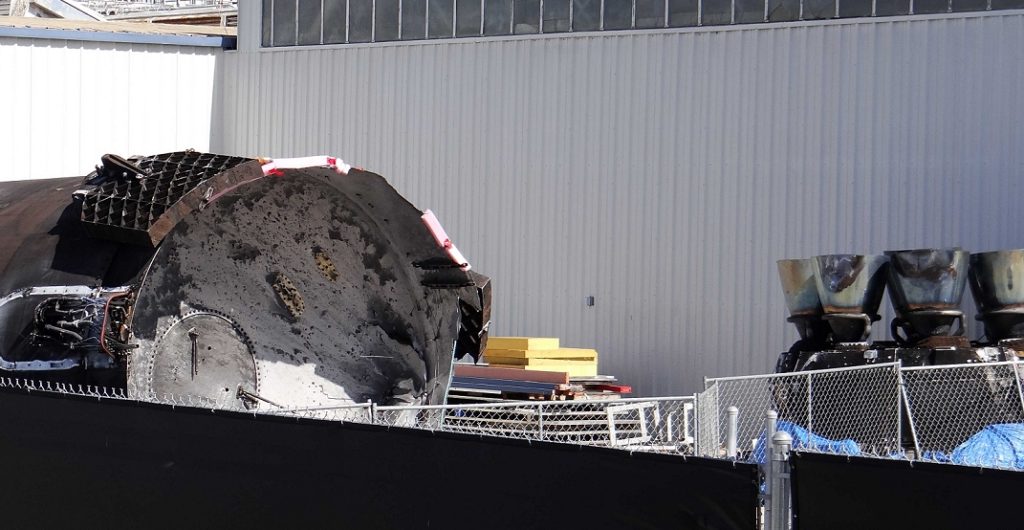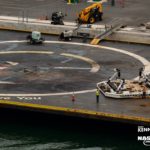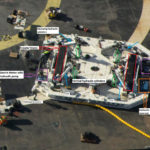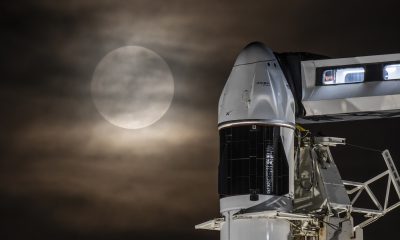News
SpaceX’s mystery “Optimus Prime” drone ship robot spotted testing ahead of BulgariaSat-1 mission
Just a little over three months ago, in mid March, fans of SpaceX caught their first full glimpses of a mysterious robot aboard the drone ship Of Course I Still Love You (OCISLY) while it was docked in Port Canaveral, Florida.
Rapidly deemed “Roomba” and later heard to be internally nicknamed “Optimus Prime”, it was approximately 50 feet (15 meters) across at its widest point and appeared to be extremely heavy due to the way it was handled on the side of the docks, as well as the presence of tracks rather than wheels. The SpaceX community quickly came to the conclusion that it was some sort of robotic tool for remotely securing Falcon 9 first stages following landings aboard SpaceX’s drone ship fleet, as first stages had a tendency to rather precariously slide about drone ships in high seas.
- Optimus Prime roving around OCISLY on June 13th. (Brady Kenniston/NASAspaceflight.com)
- Optimus Prime captured by helicopter while conducting tests in March earlier this year. (Source: Reddit /u/riddlerthc)
This speculation was proven correct during a press conference following the successful launch of SES-10 and SpaceX’s first successful reuse; the Roomba/Optimus Prime was indeed a measure to more rapidly and safely secure first stages after landing aboard drone ships. The primary reason for this robot existing is to better ensure the safety of those working aboard active drone ships. Removing the requirement for people to be aboard a barge with an unsecured 50,000 kilogram rocket that has a tendency to explode violently after falling over.

The hallowed remains of the Falcon 9 that successfully launched Jason-3 but was somewhat less successfully recovered. (NASAspaceflight)
It is currently unclear whether the robot is intended to be a precaution only used in high seas or a tool to be used for every autonomous spaceport drone ship recovery. But the fact that it was seen conducting tests aboard OCISLY just a day before SpaceX’s static fire test for the upcoming launch of BulgariaSat-1 indicates that the upcoming launch may be the robot’s first truly operational test. It is also possible that SpaceX may simply choose to recover the stage and bring it back to port before conducting tests with the robot and an actual Falcon 9 S1 aboard OCISLY, with this latter option forcing less reliance upon a currently unproven (but nevertheless rather simple) technology.
Aside from the morally prescient goal of removing safety hazards for the Falcon 9 recovery crew, the ability to remotely secure Falcon 9 first stages will also avoid the time consuming practice of welding the landing legs and hydraulic jacks to the deck of the barge. This will likely remove hours of cautious procedures designed to protect those working aboard the barge once a stage has landed. As previously discussed on Teslarati, the possibility of weekly launches occurring from Cape Canaveral later this winter or sometime in 2018 gives SpaceX significant motivation to increase the availability of OCISLY, its only East coast-based drone ship.

A Falcon 9 S1 secured the old-fashioned way with leg shoes welded to the deck and hydraulic lifts to keep weight off the legs. (NASAspaceflight)
While the several days typically required to sail several hundred miles to the barges’ recovery destinations are not about to change, the ability to remotely secure recovered stages will both drastically improve the safety of the recovery crew and allow OCISLY to spend less time on station in the Atlantic, and thus more time back in port to offload its Falcon 9 payload and prepare for the next recovery.
For SpaceX’s goal of rapid reusability, every day and even every hour that can be removed from the process of launching, recovering, and relaunching is time that could theoretically be spent launching the payloads of paying customers, or launching SpaceX’s own payloads of revenue-producing broadband satellites and data-producing Red Dragons. As the saying goes, time is money.
Elon Musk
Tesla investors will be shocked by Jim Cramer’s latest assessment
Jim Cramer is now speaking positively about Tesla, especially in terms of its Robotaxi performance and its perception as a company.

Tesla investors will be shocked by analyst Jim Cramer’s latest assessment of the company.
When it comes to Tesla analysts, many of them are consistent. The bulls usually stay the bulls, and the bears usually stay the bears. The notable analysts on each side are Dan Ives and Adam Jonas for the bulls, and Gordon Johnson for the bears.
Jim Cramer is one analyst who does not necessarily fit this mold. Cramer, who hosts CNBC’s Mad Money, has switched his opinion on Tesla stock (NASDAQ: TSLA) many times.
He has been bullish, like he was when he said the stock was a “sleeping giant” two years ago, and he has been bearish, like he was when he said there was “nothing magnificent” about the company just a few months ago.
Now, he is back to being a bull.
Cramer’s comments were related to two key points: how NVIDIA CEO Jensen Huang describes Tesla after working closely with the Company through their transactions, and how it is not a car company, as well as the recent launch of the Robotaxi fleet.
Jensen Huang’s Tesla Narrative
Cramer says that the narrative on quarterly and annual deliveries is overblown, and those who continue to worry about Tesla’s performance on that metric are misled.
“It’s not a car company,” he said.
He went on to say that people like Huang speak highly of Tesla, and that should be enough to deter any true skepticism:
“I believe what Musk says cause Musk is working with Jensen and Jensen’s telling me what’s happening on the other side is pretty amazing.”
Tesla self-driving development gets huge compliment from NVIDIA CEO
Robotaxi Launch
Many media outlets are being extremely negative regarding the early rollout of Tesla’s Robotaxi platform in Austin, Texas.
There have been a handful of small issues, but nothing significant. Cramer says that humans make mistakes in vehicles too, yet, when Tesla’s test phase of the Robotaxi does it, it’s front page news and needs to be magnified.
He said:
“Look, I mean, drivers make mistakes all the time. Why should we hold Tesla to a standard where there can be no mistakes?”
It’s refreshing to hear Cramer speak logically about the Robotaxi fleet, as Tesla has taken every measure to ensure there are no mishaps. There are safety monitors in the passenger seat, and the area of travel is limited, confined to a small number of people.
Tesla is still improving and hopes to remove teleoperators and safety monitors slowly, as CEO Elon Musk said more freedom could be granted within one or two months.
News
Tesla launches ultra-fast V4 Superchargers in China for the first time
Tesla has V4 Superchargers rolling out in China for the first time.

Tesla already has nearly 12,000 Supercharger piles across mainland China. However, the company just initiated the rollout of the ultra-fast V4 Superchargers in China for the first time, bringing its quick-charging piles to the country for the first time since their launch last year.
The first batch of V4 Superchargers is now officially up and running in China, the company announced in a post on Chinese social media outlet Weibo today.
The company said in the post:
“The first batch of Tesla V4 Superchargers are online. Covering more service areas, high-speed charging is more convenient, and six-layer powerful protection such as rain and waterproof makes charging very safe. Simultaneously open to non-Tesla vehicles, and other brands of vehicles can also be charged. There are more than 70,000 Tesla Superchargers worldwide. The charging network layout covers 100% of the provincial capitals and municipalities in mainland China. More V4 Superchargers will be put into use across the country. Optimize the charging experience and improve energy replenishment efficiency. Tesla will accompany you to the mountains, rivers, lakes, and seas with pure electricity!”
The first V4 Superchargers Tesla installed in China are available in four cities across the country: Shanghai, Zhejiang, Gansu, and Chongqing.

Credit: Tesla China
Tesla has over 70,000 Superchargers worldwide. It is the most expansive and robust EV charging network in the world. It’s the main reason why so many companies have chosen to adopt Tesla’s charging connector in North America and Europe.
In China, some EVs can use Tesla Superchargers as well.
The V4 Supercharger is capable of charging vehicles at speeds of up to 325kW for vehicles in North America. This equates to over 1,000 miles per hour of charging.
Elon Musk
Elon Musk hints at when Tesla could reduce Safety Monitors from Robotaxi
Tesla could be reducing Safety Monitors from Robotaxi within ‘a month or two,’ CEO Elon Musk says.

Elon Musk hinted at when Tesla could begin reducing Safety Monitors from its Robotaxis. Safety Monitors are Tesla employees who sit in the front passenger seat during the driverless rides, and are there to ensure safety for occupants during the earliest rides.
Tesla launched its Robotaxi fleet in Austin last Sunday, and after eight days, videos and reviews from those who have ridden in the driverless vehicles have shown that the suite is safe, accurate, and well coordinated. However, there have been a few hiccups, but nothing that has put anyone’s safety in danger.
A vast majority — close to all of the rides — at least according to those who have ridden in the Robotaxi, have been performed without any real need for human intervention. We reported on what was the first intervention last week, as a Safety Monitor had to step in and stop the vehicle in a strange interaction with a UPS truck.
Watch the first true Tesla Robotaxi intervention by safety monitor
The Tesla and UPS delivery truck were going for the same street parking space, and the Tesla began to turn into it. The UPS driver parallel parked into the spot, which was much smaller than his truck. It seemed to be more of an instance of human error instead of the Robotaxi making the wrong move. This is something that the driverless cars will have to deal with because humans are aggressive and sometimes make moves they should not.
The Safety Monitors have not been too active in the vehicles. After all, we’ve only seen that single instance of an intervention. There was also an issue with the sun, when the Tesla braked abnormally due to the glare, but this was an instance where the car handled the scenario and proceeded normally.
With the Robotaxi fleet operating impressively, some are wondering when Tesla will begin scaling back both the Safety Monitors and Teleoperators that it is using to ensure safety with these early rides.
CEO Elon Musk answered the inquiry by stating, “As soon as we feel it is safe to do so. Probably within a month or two.”
As soon as we feel it is safe to do so.
Probably within a month or two. We continue to improve the Tesla AI with each mile driven.
— Elon Musk (@elonmusk) June 30, 2025
Musk’s response seems to confirm that there will be fewer Teleoperators and Safety Monitors in the coming months, but there will still be some within the fleet to ensure safety. Eventually, that number will get to zero.
Reaching a point where Tesla’s Robotaxi is driverless will be another significant milestone for the company and its path to fully autonomous ride-sharing.
Eventually, Tesla will roll out these capabilities to consumer-owned vehicles, offering them a path to generate revenue as their car operates autonomously and completes rides.
For now, Tesla is focusing on perfecting the area of Austin where it is currently offering driverless rides for just $4.20 to a small group of people.
-

 News5 days ago
News5 days agoTesla Robotaxi’s biggest challenge seems to be this one thing
-

 News2 weeks ago
News2 weeks agoTesla confirms massive hardware change for autonomy improvement
-

 Elon Musk2 weeks ago
Elon Musk2 weeks agoElon Musk slams Bloomberg’s shocking xAI cash burn claims
-

 News2 weeks ago
News2 weeks agoTesla features used to flunk 16-year-old’s driver license test
-

 News2 weeks ago
News2 weeks agoTesla China roars back with highest vehicle registrations this Q2 so far
-

 News2 weeks ago
News2 weeks agoTexas lawmakers urge Tesla to delay Austin robotaxi launch to September
-

 News2 weeks ago
News2 weeks agoTesla dominates Cars.com’s Made in America Index with clean sweep
-

 News2 weeks ago
News2 weeks agoTesla’s Grok integration will be more realistic with this cool feature























